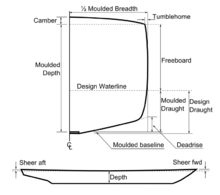
Sheer (ship)
The sheer is a measure of longitudinal main deck curvature, in naval architecture. The sheer forward is usually twice that of sheer aft. Increases in the rise of the sheer forward and aft builds volume into the hull, and in turn increases its buoyancy forward and aft, thereby keeping the ends from diving into an oncoming wave and slowing the ship. In the early days of sail, one discussed a hull's sheer in terms of how much "Hang" it had. Sutherland's 1711 Ship Builders Assistant covers this information in more detail.
The practice of building sheer into a ship dates back to the era of small sailing ships. These vessels were built with the decks curving upwards at the bow and stern in order to increase stability by preventing the ship from pitching up and down.
Sheer on exposed decks makes a ship more seaworthy by raising the deck at fore and aft ends further from the water and by reducing the volume of water coming on deck.
See also
References
Sheer
Sheer may refer to:
See also

Sheer fabric
Sheer fabric is fabric which is made using thin thread and/or low density of knit and which results in a semi-transparent and flimsy cloth. Some fabrics become transparent when wet.
The sheerness of a fabric is expressed as a numerical denier which ranges from 3 (extremely rare, very thin, barely visible) to 15 (standard sheer for stockings) up to 30 (semi opaque) until 100 (opaque). The materials which can be made translucent include gossamer, silk, rayon or nylon. Sheer fabric comes in a wide variety of colors, but for curtains white and shades of white, such as cream, winter white, eggshell, and ivory are popular. In some cases, sheer fabric is embellished with embroidered patterns or designs.
A common use for sheer fabric is in curtains, which allows for sunlight to pass through during daylight, while maintaining a level of privacy. Due to the loose weave in sheer fabrics curtains offer little heat insulation. However, when it is lighter on the inside of a room than it is on the outside (such as at nighttime), then the inside of the room can be seen from the outside.

Ship
A ship is a large buoyant watercraft. Ships are generally distinguished from boats based on size, shape and cargo or passenger capacity. Ships are used on lakes, seas,rivers,and oceans for a variety of activities, such as the transport of people or goods, fishing, entertainment, public safety, and warfare. Historically, a "ship" was a sailing vessel with at least three square-rigged masts and a full bowsprit.
In armed conflict and in daily life, ships have become an integral part of modern commercial and military systems. Fishing boats are used by millions of fishermen throughout the world. Military forces operate vessels for naval warfare and to transport and support forces ashore. Commercial vessels, nearly 35,000 in number, carried 7.4 billion tons of cargo in 2007. As of 2011, there are about 104,304 ships with IMO numbers in the world.
Ships were always a key in history's great explorations and scientific and technological development. Navigators such as Zheng He spread such inventions as the compass and gunpowder. Ships have been used for such purposes as colonization and the slave trade, and have served scientific, cultural, and humanitarian needs. After the 16th century, new crops that had come from and to the Americas via the European seafarers significantly contributed to the world population growth.Ship transport has shaped the world's economy into today's energy-intensive pattern.
Ship (disambiguation)
A ship is a large vessel that floats on water, specifically the ocean and the sea.
Ship or ships may also refer to:
Acronyms:
In the arts:
Ship (comics)
The fictional A.I. entity originally known as Ship has appeared in several incarnations in the Marvel Universe. At times controlled by both the X-Men and their enemies, the sentient A.I. has at times been installed in the core of a Celestial starship, two space stations, and a techno-organic being. It is not related to Star-Lord's "Ship".
Fictional character biography
Ancient history
Ship's A.I. was created untold millennia ago by the Celestials as the operating system for a data collection device. The Celestials had genetically manipulated humanity, and they left the Ship in the area that would come to be known as Mongolia to monitor humanity's progress.
Circa 1100 A.D., a Mongolian immortal known as Garbha-Hsien (later known as Saul), discovered the Ship and lived next to it while he researched its mysteries. Saul never attempted to enter the Ship.
In time, the Egyptian immortal En Sabah Nur learned of Saul and sought him out as another immortal. In a confrontation, En Sabah Nur slew all of Saul's guards. Saul then sought to humble his fellow "forever-walker" by revealing the secret titanic vessel. Having had previous experience with futuristic technology due to his encounters with Rama-Tut, Nur attacked Saul and left the other immortal for dead and entered the Ship. He emerged later as a vastly changed being who now called himself Apocalypse.
Podcasts:

